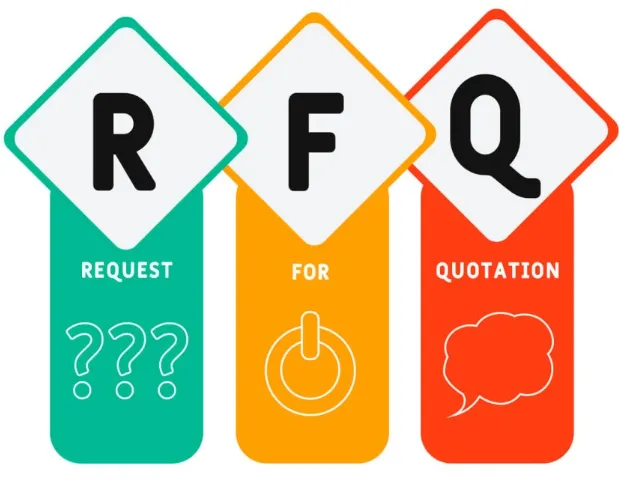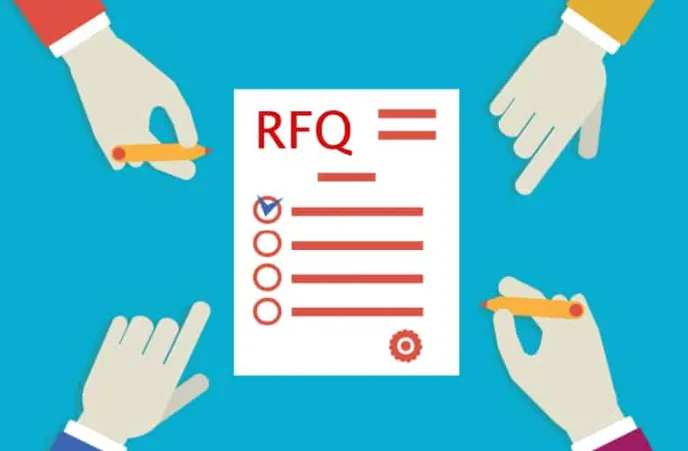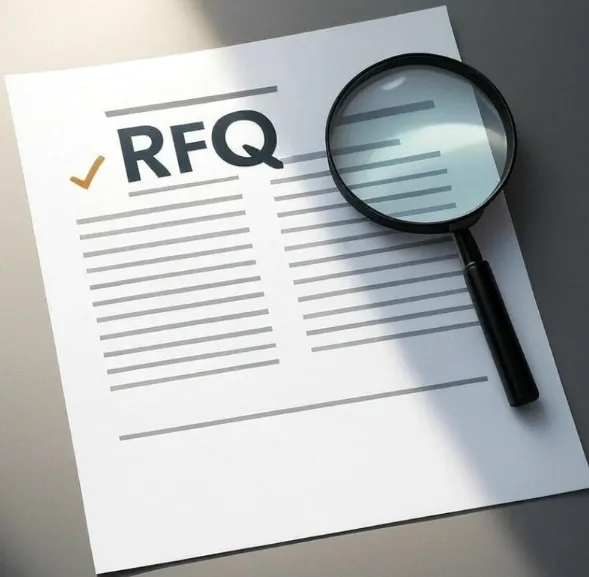What is RFQ in Procurement? The

Picture this: you need to buy 500 new office chairs. You call three different suppliers, and each one gives you a different price, a different delivery date, and includes different things in their offer. How do you compare them fairly? How do you know you're getting the best deal, and not just the cheapest price?
This is the exact problem a Request for Quotation (RFQ) is designed to solve.
If you're new to procurement or just need a refresher, you've come to the right place. This guide won't just define RFQ—we'll show you exactly how to use it, complete with real-world examples and free templates you can use today.
Let's dive in.

In a nutshell, a Request for Quotation (RFQ) is a formal document you send to suppliers when you know exactly what you need and you're ready to buy.
Its primary goal is to get comparable prices. You're not looking for creative ideas or solutions; you're asking a simple question: "For this specific thing, what's your best price?"
You use an RFQ when your requirements are clear, quantifiable, and unlikely to change. Think of things like:
500 units of a specific computer model
10,000 meters of a particular grade of steel
Office cleaning services for a 50,000 sq. ft. building for one year
The key here is standardization. By sending the same detailed requirements to multiple suppliers, you force them to compete on a level playing field. This makes your decision data-driven, not based on a gut feeling.
This is where many people get tripped up. These three acronyms are related, but they serve very different purposes. Here's the simplest way to think about it:
| When to Use It | The Core Question You're Asking | |
|---|---|---|
| RFI (Request for Information) | You're exploring the market. | "What can you do?" |
| RFP (Request for Proposal) | You have a complex problem and need a solution. | "How would you solve this?" |
| RFQ (Request for Quotation) | You know exactly what you need and are ready to buy. | "What's your price for this?" |
Here's the deal: Sending an RFP when you need an RFQ will annoy suppliers with unnecessary work. Sending an RFQ when you need an RFP will get you prices for solutions that don't actually meet your needs. Picking the right tool is half the battle.

A great RFQ process is methodical. It ensures fairness, transparency, and gets you the best result. Let's break it down.
Step 1: Nail Down Your Requirements
Before you write a single word, be 100% clear on what you're buying. Create a detailed specification sheet. For office chairs, this would include dimensions, materials, weight capacity, and color. Ambiguity here is your biggest enemy.
Step 2: Build Your Supplier Shortlist
You can't just pick names from a hat. Identify 3-5 qualified suppliers who have a proven track record of delivering what you need. This pre-qualification is crucial for saving time later.
Step 3: Craft the RFQ Document
This is your blueprint. A strong RFQ includes:
Clear background and instructions
Detailed technical specifications
Commercial terms (delivery date, payment terms, etc.)
A clear submission format (use our template below!)
Step 4: Launch and Manage Communication
Send the RFQ to all suppliers at the same time. Set a realistic deadline (usually 1-3 weeks). Be available to answer any clarifying questions, and share the answers with all bidders to maintain fairness.
Step 5: Receive and Organize Responses
As quotes come in, log them in a standardized spreadsheet. This makes the next step much easier.
Step 6: Evaluate and Award
This isn't just about picking the lowest number. Create a simple scorecard. Rate each supplier on price, delivery time, and past performance. The lowest price might come from a supplier known for missing deadlines—is that a risk you can take?
Step 7: Debrief and Onboard
Notify the winning supplier and, just as importantly, inform the others why they were not selected. This builds good long-term relationships. Then, move swiftly to contract signing.

Theory is good, but practice is better. Let's look at how this works across different industries.
Example 1: Manufacturing - Sourcing a Custom Component
Scenario: You need 5,000 custom-machined aluminum brackets.
The RFQ Must Specify: Technical drawings (CAD files), material grade (e.g., Aluminum 6061), tolerances, surface finish, and packaging requirements.
Supplier Question: Without these details, one supplier might quote for a weaker alloy, and another might include a costly finish you don't need. Your comparisons would be worthless.
Example 2: IT Procurement - Buying Laptops
Scenario: Equipping a new team of 50 employees.
The RFQ Must Specify: Exact model or minimum specs (CPU, RAM, SSD), included software, warranty length, and delivery schedule.
Pro Tip: Ask for the Total Cost of Ownership (TCO), which includes the price of potential future repairs or extended warranty, not just the sticker price.
Today, procurement isn't just about cost. It's about value. And that includes environmental and social value. Your RFQ is a powerful tool to drive your sustainability goals.
You can easily add a sustainability section to your RFQ with questions like:
"What percentage of recycled material is used in this product?"
"Can you provide documentation of your ethical labor practices?"
"What is your company's policy on carbon emissions reduction?"
This signals to suppliers that you value responsible business practices, and it gives you concrete data to factor into your decision.
We've seen these errors time and again. Avoid them, and you'll be ahead of the curve.
Vague Specifications: "We need some office chairs" will get you wildly different quotes. Be specific.
Ignoring Total Cost of Ownership: The cheapest product might have high maintenance costs or a short lifespan. Think beyond the initial price.
Poor Supplier Prequalification: Sending an RFQ to an unqualified supplier wastes everyone's time. Do your homework first.
Unclear Evaluation Criteria: If suppliers don't know how you'll judge them (e.g., 70% price, 30% delivery speed), they can't give you their best offer.
The "Black Hole" of Communication: Not responding to questions or failing to give feedback to unsuccessful bidders burns bridges.

How you manage your RFQ process depends on the complexity and volume of your purchasing.
Spreadsheets & Email: Perfect for small companies with simple, infrequent RFQs. It's free and flexible, but can become chaotic quickly.
E-Sourcing Platforms: Tools like Fairmarkit or Deep Stream automate the entire process—from sending out RFQs to collecting and analyzing responses. This is a huge time-saver for frequent, complex sourcing.
Full-Suite Procurement Software: Solutions like Sievo or Coupa integrate RFQs into a larger procurement ecosystem, linking them to contracts, spend analytics, and invoicing.
Your choice should be based on one question: How much time are we currently wasting on manual RFQ tasks?
You're now equipped to run an RFQ process that is fair, efficient, and delivers real value.
Here’s how to start:
Identify a pilot project with clear, straightforward requirements.
Download our Free RFQ Toolkit to get a head start.
Run your RFQ using the 7-step process outlined above.
1. Q: How many suppliers should I send an RFQ to?
A: There's a sweet spot. Sending to only 2-3 suppliers might not create enough competition. Sending to 10+ is inefficient and burdensome for you and them. We recommend a shortlist of 4 to 6 pre-qualified suppliers. This gives you a healthy range of options to compare without overwhelming your capacity to manage the process effectively.
2. Q: What should I do if a supplier asks for clarification after I've sent the RFQ?
A: This is common and a sign of an engaged supplier. The golden rule is transparency and fairness. Answer the question clearly, and then send that exact clarification to every supplier who received the RFQ. This ensures a level playing field and prevents any single bidder from having an information advantage.
3. Q: Is an RFQ legally binding once a supplier submits a quote?
A: No, not typically. An RFQ is an invitation for suppliers to make an offer (their quote). You are not obligated to accept any of them. The legal contract is formed only when you issue a formal Purchase Order (PO) or sign a contract based on that quote. Always include language in your RFQ stating that it is not a commitment to purchase.
4. Q: A supplier's quote came in much lower than the others. Is this always the best choice?
A: Be cautious. A quote that is significantly lower can be a red flag. The supplier may have misunderstood the requirements, be using lower-quality materials, or have made a costing error (which they might try to correct later). It's your responsibility to scrutinize that quote extra carefully and ask clarifying questions before awarding the business.
5. Q: Can I negotiate after receiving RFQ responses?
A: Absolutely. The RFQ process often opens the door for negotiation. You can go back to your preferred supplier(s) and ask if they can improve their offer, especially if you have a more competitive bid from another qualified supplier. This final step can often secure you even better terms or pricing.
6. Q: How long should I give suppliers to respond?
A: It depends on the complexity. For simple, off-the-shelf items, 1-2 weeks is usually sufficient. For more complex, custom-made goods or services, allow 2-4 weeks. Always be realistic—rushing suppliers can lead to inaccurate quotes or discourage your best partners from bidding.
7. Q: What's the best way to handle an incumbent supplier (our current provider)?
A: Include them in the process, but don't give them special treatment. They must compete on the same terms as the new potential suppliers. This is crucial for validating that you are still getting a fair market price and good service. Sometimes the incumbent wins, and the process reinforces their value; other times, you find a better partner.
8. Q: A key supplier declined to participate in our RFQ. Why would they do this?
A: There are a few common reasons. They might be at full capacity and too busy to take on new work. Your RFQ might not be financially attractive enough for them. Or, they may perceive your process as unfair or biased toward a cheaper competitor. It's worth a polite follow-up call to understand their reasons—their feedback can be invaluable.
9. Q: Should we always award to the lowest-priced, qualified bidder?
A: Not necessarily. The goal is best value, not just lowest price. Your evaluation criteria should reflect this. If a supplier is 5% more expensive but offers a 10% better delivery time and superior after-sales support, they may deliver greater overall value to your business. Use a scoring model to make this decision objectively.
10. Q: We use digital signatures. Is an emailed quote with a digital signature considered valid?
A: In most business contexts, yes. An electronic signature or even a formal quote on company letterhead sent via email is typically considered a valid and binding offer from the supplier. Just ensure your RFQ terms state that electronic submissions are acceptable.
Contact us
Call Us: +86 193 7668 8822
Email:[email protected]
Add: Building B, No.2, He Er Er Road, Dawangshan Community, Shajing Street, Bao'an District, Shenzhen, China